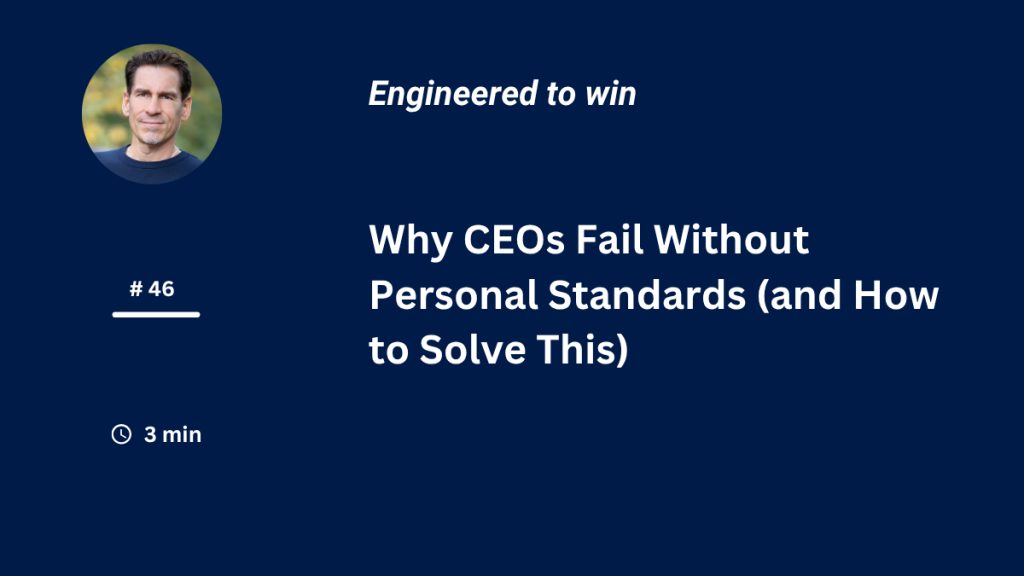You think it’s a systems problem.
But it’s a CEO personal standards problem.
Most founders are obsessed with optimizing their teams, tech, or time.
But the real bottleneck? The absence of personal standards that guide decisions, protect energy, and reinforce identity.
If you’re making exceptions without ever defining your expectations, your leadership is being negotiated by default, not by design.
What you tolerate becomes your ceiling
Let that land.
- Say yes when you mean maybe? That’s your new operating norm.
- Let that underperformer slide again? That’s your leadership brand.
- Take that call on your blocked day? You just told your nervous system it doesn’t matter.
Most CEOs don’t lack vision.
They lack standards.
And it’s not their fault. Most never had a model for what high personal standards even look like.
They were raised by parents who avoided conflict, craved approval, or confused boundaries with punishment.
So they inherited the myth:
“Be agreeable. Work harder. Don’t rock the boat.”
That’s how people-pleasing and perfectionism sneak in.
The neuroscience of decision fatigue
MIT research shows that the average adult makes over 35,000 decisions a day [source: Real Simple on decision fatigue]
The quality of those decisions? Depends entirely on the clarity of your internal operating system.
Without standards, every decision gets negotiated in real time. That burns prefrontal glucose—fast.
But when you set personal standards—like “I don’t check email before 10am,” or “I end every meeting with a clear owner”—your brain offloads the decision-making burden to the basal ganglia (your habit brain).
Translation:
You become more consistent, less reactive, and more respected—without adding more effort.
How to Raise Your CEO Personal Standards (and Make Them Stick)
Here’s the quiet protocol I’ve used with dozens of high-performing CEOs to reset their CEO personal standards.
1. Identify your invisible leaks
Ask: Where am I resentful, exhausted, or overextended?
That’s usually a sign you’re violating your own boundaries.
2. Declare your non-negotiables
Use the phrasing:
“From now on, I’m the kind of CEO who…”
Examples:
- “I coach, I don’t coddle.”
- “I don’t take meetings after 3pm.”
- “I respond to issues, not emotions.”
3. Make exceptions impossible
This is the hard part. Standards don’t work unless they are binary.
If it’s flexible, it’s not a standard—it’s a suggestion.
And suggestions don’t scale.
That’s why CEO personal standards must be clearly defined and binary. Without them, growth becomes unpredictable.
If you want to see how raising your standards is the first step to exponential growth, read this: Why 10x Growth is Easier Than 2x
Set One Standard That Ripples Through Everything
Set a single personal standard that will ripple through your week.
Start with one of these:
- “I don’t give feedback in Slack.”
- “I walk away from deals that don’t feel clean.”
- “I protect 90 minutes of deep work before noon.”
Bonus: Write it on a sticky note and put it on your laptop.
Want to learn how small behavior changes lead to massive momentum? Read: The 1% Traction Rule
Leadership Isn’t About Goals—It’s About Standards
In his viral piece on Amazon’s Leadership Principles, Jeff Bezos said:
“We don’t raise the bar in our hiring process until we raise the bar for ourselves.”
Great companies aren’t built on goals.
They’re built on standards that get enforced—ruthlessly, repeatedly, without apology.
The moment a leader gets clear on what they will and won’t tolerate, everything changes.
Where are you allowing exceptions to become your rule?
You don’t need a new system.
You need a set of CEO personal standards that make decisions automatic, and progress inevitable.
If this hit, reply and tell me:
What’s one standard you need to make non-negotiable this quarter?
Or forward this to a founder who keeps slipping on their boundaries—and needs this wake-up call.
Next week: Why stress is a signal, not a sentence (and how to alchemize it into power in 90 seconds).

